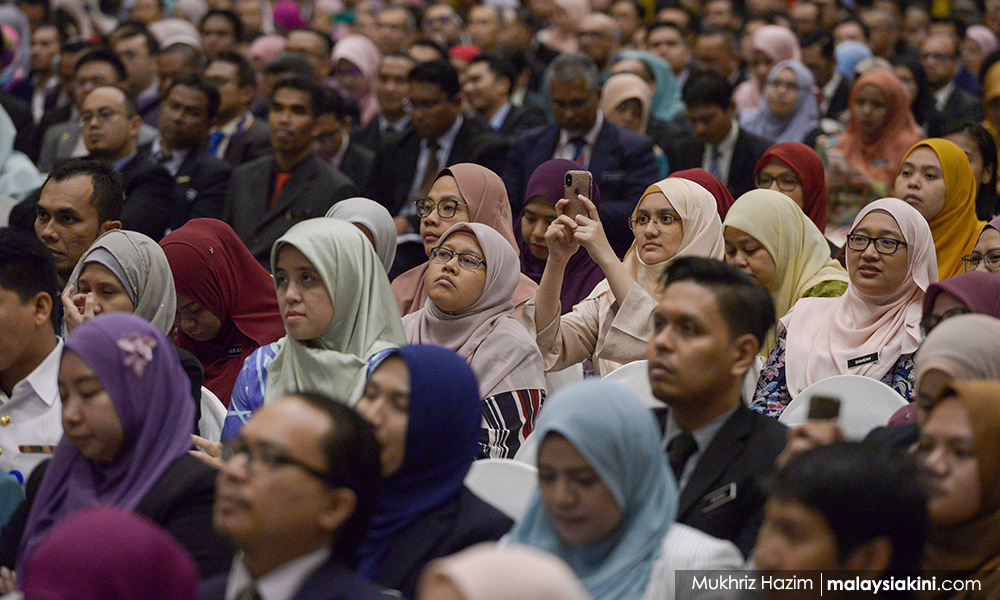
Did a 2017 paper really find non-Malays to be prolific bribe-givers?
Over the last two weeks, PAS president Abdul Hadi Awang has come under attack over his assertion that non-Muslims and non-Bumiputera comprise the bulk of the “root of corruption” in Malaysia.
In his defence, the party’s central committee member Mohd Zuhdi Marsuki claimed a study found that most people convicted of giving bribes between 2010 and 2014 were non-Malays.
While he did not give specifics, a paper regarding bribery in Malaysia began making the rounds online among PAS supporters.
The peer-reviewed paper was published in the journal Asian Economic Papers in January 2017 and contained many of the figures that Zuhdi had quoted.
This includes, according to the study’s analysis, that only 12.03 percent of convicted bribe-givers from 2010 to 2014 are Malays, even though they make up 61.81 percent of the population as of 2011.
Meanwhile, 57.46 percent of bribe-givers were Chinese and 15.92 percent were “Indian and others”.
But does this mean Hadi and Zuhdi were justified in their assertions?

PAS president Abdul Hadi Awang
As with the norm with academic papers, there are significant caveats and nuances in the paper that cannot be easily glossed over.
What is the paper really about?
The study was conducted by researchers based at Universiti Sains Malaysia and Tunku Abdul Rahman University College in Penang.
The analysis was based on information gleaned from the MACC’s Corruption Offender Database which is publicly accessible through the commission’s website.
The database contains information on both convicted bribe-givers and bribe-recipients.
However, the analysis is mostly focused on the bribe-givers’ perspective, particularly the factors that could lead to a larger bribe being offered.
In other words, the role of bribe recipients in corruption are mostly outside the scope of the paper and left unexplored.
What does it say about race?
While the paper does make several observations about race, it also spells out several caveats regarding the observations as well as pitfalls of relying on the MACC database.
As with the norm with academic papers, there are significant caveats and nuances in the paper that cannot be easily glossed over.
What is the paper really about?
The study was conducted by researchers based at Universiti Sains Malaysia and Tunku Abdul Rahman University College in Penang.
The analysis was based on information gleaned from the MACC’s Corruption Offender Database which is publicly accessible through the commission’s website.
The database contains information on both convicted bribe-givers and bribe-recipients.
However, the analysis is mostly focused on the bribe-givers’ perspective, particularly the factors that could lead to a larger bribe being offered.
In other words, the role of bribe recipients in corruption are mostly outside the scope of the paper and left unexplored.
What does it say about race?
While the paper does make several observations about race, it also spells out several caveats regarding the observations as well as pitfalls of relying on the MACC database.

The most significant of these is that the database only contains information on those who have been convicted.
This meant no analysis can be done on those who did not engage in bribery, those who did but were not caught, and those who were caught but were not convicted.
“These omissions are likely to bias our estimates. Unfortunately, there are no ready means to correct for this selection bias,” the authors noted.
The authors did observe - with caveats - that bribe-givers are predominantly non-Malay.
They surmised that most bribe-giving took place in the course of dealings with government employees who are predominantly Malay.
“Of course, these findings are merely suggestive as it is unsafe to draw conclusions based solely on the profile of convicted bribe-givers,” the authors cautioned.
The authors also noted that while Malays only make up a smaller proportion of bribe-givers, they have a higher probability of offering larger bribes.
Malaysiakini has contacted the paper’s lead author for comment regarding the recent focus on their findings.
What else did they find?
Between 2010 and 2014, the 449 people convicted for bribery sought to avoid fines totalling RM83.9 million and gain another RM262.7 million for themselves by unduly swaying decisions in their favour.
The authors said this provides a minimum estimate for the losses due to bribery in Malaysia.
Most of the people on the receiving end of that bribe are civil servants. Despite this, the bribes given to them are generally lower than those offered to private sector employees.

“State and federal public sector employees received about 71 percent and 64 percent lower bribes, respectively, when compared with bribes paid to private sector employees who accounted for just 9 percent of bribe recipients,” they said.
The study also found that the amount of the bribe offered tends to increase when the bribe-giver is trying to avoid a stiffer fine or jail term, as opposed to a lesser punishment.
This can be circumvented by removing the “human element” in booking an offender, such as through the use of automated speed traps and traffic light cameras, the study’s authors suggested.
Stiffer fines may backfire
Meanwhile, lengthy jail terms for corruption appeared to have the desired effect of deterring graft.
However, punishing corruption with increased fines appeared to have the opposite effect of increasing the size of the bribe offered. They said this backfiring effect has already been seen in other studies elsewhere.
“This is consistent with the view that whereas higher fines may deter bribe-giving (the incidence of bribery), it encourages larger bribes if one is caught for bribery. Imprisonment, on the other hand, had the desired deterrent effect.
“The remedy is not necessarily to make imprisonment a mandatory penalty for bribery, regardless of the sums offered, or to reduce the fines for bribe-giving.
“There must be a fine balance between the two because although fines increase revenues. Imprisonment, despite its deterrent effect, imposes a larger cost on society on account of expenditures to maintain incarcerated individuals,” they said.
A relatively “costless” alternative to deter corruption is to punish it with whipping, though the authors noted that this could rile up human rights activists.
Ultimately, they said the best deterrent to crime is “effective enforcement that raises the probability of being caught, swift prosecution, and penalties that bear a strict correspondence to the sum of bribes offered”.
There is a certain truth to it, but simply characterising it in Racial terms is misleading.
ReplyDeleteLarge businesses and organisations tend to have the wherewithal to ensure proper compliance with government regulations and resist pressure to pay "Lubricating Oil" to facilitate government transactions.
Much of the corruption in Malaysia occurs between government officials and small and medium scale businesses.
It is unfortunately the structure in Malaysia that Government officers are nearly 100 % Malay and majority of SMEs are Chinese-owned.
I suspect there was a lack in the analysis with regard to the bribe-recipient simply because the majority is Malay. It does not paint a nice picture of Malays. Thus, the emphasis on bribe-givers.
ReplyDeleteFrankly, this is a wrong approach because both the giver and recipient should be pulled up and charged. And unless you do an honest study for both giver and recipient, you will not be able to provide some solution.
Trying to "protect" the image of one race is the most stupid thing to do in this instance. Like how some stupid a**e-holes are using the incomplete data to blame mainly the Chinese for corruption in Malaysia.
rather than the 'giver' and the 'recipient', why not the 'demander' and the 'compliant'
DeleteSpot on!
DeleteBlame the armed twisted givers but ignore the never-ending demanders!
Those in the know - know who's who.
Truly shameless.